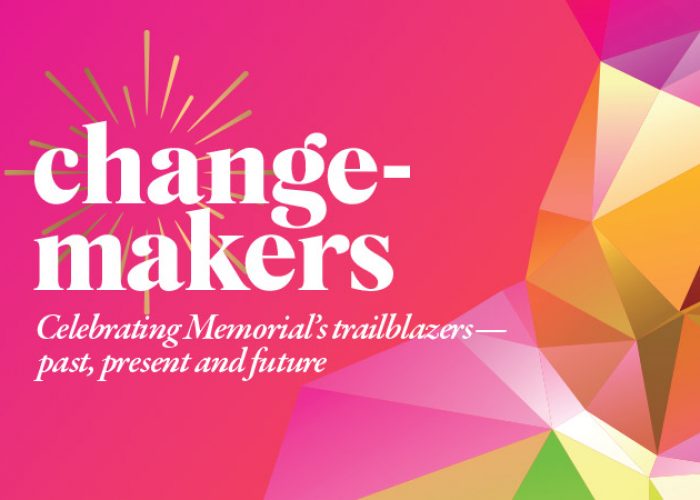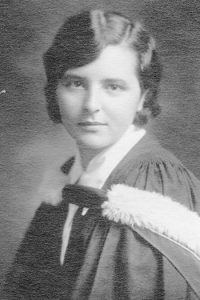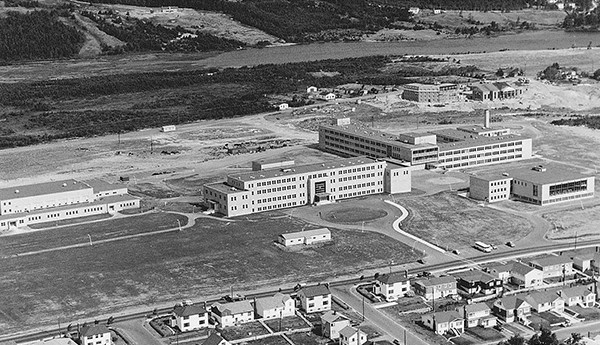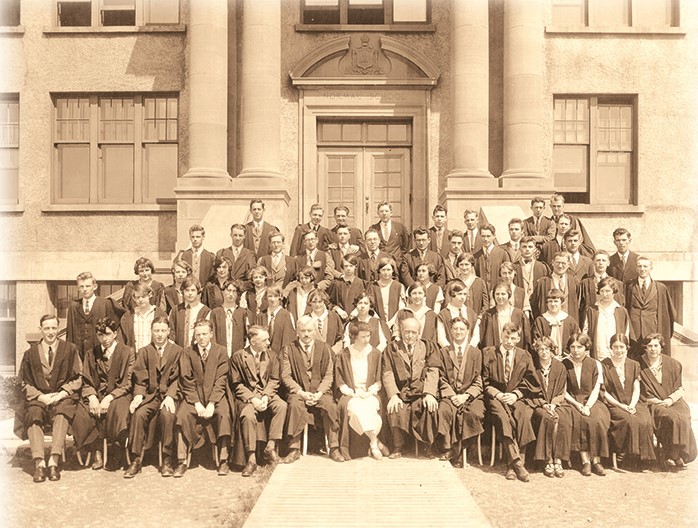A HISTORY OF CHANGE-MAKERS
By Kristine Power, MA'02

WHEN MEMORIAL UNIVERSITY COLLEGE officially opened in St. John’s on Sept. 15, 1925, there were more people than seats in the Parade Street building.
Attendees spilled out onto the balconies overlooking the building’s main hall.
The Evening Telegram called the college “Newfoundland’s Great Advance” and hailed the opening as an “epoch-marking event” that signified the hope, progress and development of an entire country.
In its inaugural report, students and faculty are described as “one enlarged family with one heart and mind.” There is an archival photo of this first class of 57 students and five faculty posing in front of the college’s concrete columns wearing scholarly gowns. They look at the camera with the same alchemy of joy and trepidation on their faces that can be seen on many of today’s students. Near the centre is John Lewis Paton, the college’s president. He seems to be daring the students to dream of a better future only they themselves can build. And that is exactly what they did.

Memorial University College’s first graduate was a trailblazer: a woman. Dr. Helena Frecker (née McGrath) was a recipient of the Jubilee Scholarship. She graduated from the college in 1926, and then earned a BA(Hons.) and an MA from the University of Toronto in 1928 and 1930. She would go on to teach at Memorial University off and on until 1975.
From 1974-75 Memorial University celebrated its 50th year. As part of that celebration, Dr. Frecker was awarded an honorary degree. In her convocation address, she shared her impressions of her time at the college and the influence Paton had on his students.
“He tried to pass on to us the conviction that we as a privileged few (perhaps through circumstance rather than through any intrinsic merits of our own) must always remember that for every privilege, for every right, there is a corresponding duty and responsibility. It was our duty to turn our college education not only to personal profit and advancement, but to the good of the whole community.”
THE EARLY YEARS
During the next decade, the college continued to grow. By 1935 there were 220 students and 12 faculty. There were four labs, a lecture hall, a gymnasium and a library that housed a collection of 8,000 books.
A pivotal turning point came in 1949. One of the first acts by the provincial government of the new Canadian province of Newfoundland was to create legislation making Memorial University a degree-granting institution.
Then-premier Joseph Smallwood stated during his address to the Newfoundland House of Assembly on Aug. 11, 1949:
“There is no reason, if we have the vision and if we have the courage . . . the university of Newfoundland for its size should not be the most distinguished university in the whole world.”
Then, in 1951, the provincial government chose an 80-acre site for a new campus on Elizabeth Avenue, which was at that time on the outskirts of St. John’s.

THE FIRST 100 YEARS
Memorial University continues to evolve and adapt: first with its Elizabeth Avenue campus and subsequently with the establishment of professional schools in nursing, medicine, social work, engineering and the creation of new programs and campuses.
In an address to the St. John’s Rotary Club in 1961, Moses O. Morgan, then a dean of arts and science at Memorial, described Memorial during this important chapter of expansion and growth:
“[Memorial] is and must remain unique, with its roots deep in the traditions of the university college and more profoundly in the traditions of this province. It must remain of Newfoundland, reflecting the ethos of its people and their aspirations, as it remains both the gateway and a contributor to a fuller life.”
From 57 to more than 19,000 students from 115 countries, Memorial University now has six campuses: St. John’s campus (1961), Harlow Campus (1968), Grenfell Campus (1975), Marine Institute (1992), Signal Hill Campus (2018) and Labrador Campus (2022).
Memorial’s greatest accomplishment is the cumulative sea change of its more than 100,000 alumni from near and far, who carry with them a connection, a sense of community and an experience intrinsically tied to their time at Memorial University in Newfoundland and Labrador.
Almost 100 years ago, John Lewis Paton wrote Memorial’s motto himself in the first college report, “Launch forth into the deep.” It described the meaning of the motto and why he chose it: use the power of education to escape from the smallness and narrowness of life and think about life in expansive ways.
This motto remains enshrined in the work of Memorial University’s students, faculty and staff and reminds us to make the world a better place, wherever we are.
[Editor’s note: This article owes an incredible debt to Celebrate Memorial!: A Pictorial History of Memorial University of Newfoundland by Dr. Melvin Baker and Jean Graham, as well as to the research expertise found in the Archives and Special Collections Division and the Centre for Newfoundland Studies of Memorial University Libraries.]


